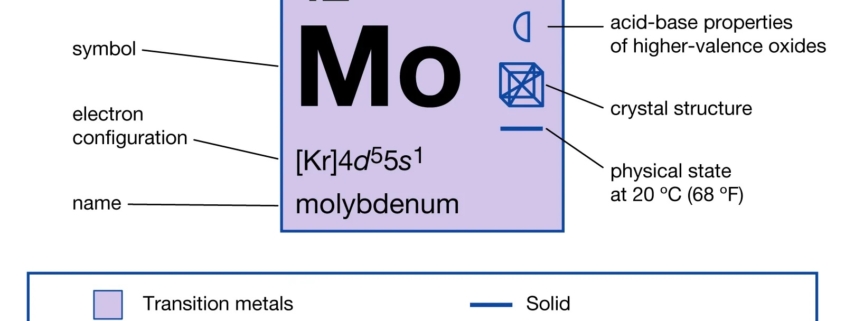Molybdenum and its applications
Molybdenum applications
Molybdenum, atomic number 42, is a transition metal, the second member of Group 6 of the Periodic Table, between chromium and tungsten.
It has one of the highest melting temperatures of all the elements, yet unlike most other high-melting point metals, its density is only 25% greater than iron’s. Its coefficient of thermal expansion is the lowest of the engineering materials, while its thermal conductivity exceeds all but a handful of elements.
| Molybdenum properties | |
| Atomic number | 42 |
| Atomic weight | 95.96 |
| Crystal structure | Body-centered cubic (BCC) |
| Lattice constant | a = 3.1470 Å |
| Density | 10.22 g/cm3 |
| Melting temperature | 2623°C |
| Coefficient of thermal expansion | 4.8 x 10-6 / K at 25°C |
| Thermal conductivity | 138 W/m K at 20°C |
Molybdenum metal and molybdenum-based alloys have a unique combination of properties, including:
- High strength at elevated temperatures
- High thermal and electrical conductivity
- Low thermal expansion
Molybdenum metal and its alloys are therefore the first choice in many demanding specialized applications in electronics, heat treatment and metal processing.
Nickel-based alloys
Molybdenum is a very important alloying element in high-performance nickel-based alloys. These alloys fall into two basic classes:
- Corrosion-resistant alloys
- High-temperature alloys. The high-temperature alloys can be further subdivided into two categories:
- solid-solution strengthened
- age-hardenable
The nominal compositions in weight percent of some of the commercially important alloys of each type are given in Tables 1 and 2.
Corrosion-resistant nickel-based alloys
| Alloy | UNS No | EN No | Ni | Cr | Fe | Mo | W | C | Cu |
| B-3® | N10675 | 2.46 | 65** | 1.5 | 1.5 | 28.5 | 3* | 0.01* | 0.2* |
| C-276 | N10276 | 2.4819 | 57 | 16 | 5 | 16 | 4 | 0.01* | 0.5* |
| C-22® | N06022 | 2.4602 | 56 | 22 | 3 | 13 | 3 | 0.01* | 0.5* |
| C-2000® | N06200 | 2.4675 | 59 | 23 | 3* | 16 | – | 0.01* | 1.6 |
| G-30® | N06030 | 2.4603 | 43 | 30 | 15 | 5.5 | 2.5 | 0.03* | 2 |
| G-35® | N06035 | 2.4643 | 58 | 33.2 | 2* | 8.1 | 0.6* | 0.05* | 0.3* |
| * Maximum ** Minimum | |||||||||
Table 1: Nominal compositions of some corrosion-resistant nickel-based alloys
High-temperature alloys
| Alloy | UNS No | EN No | Ni | Co | Fe | Cr | Mo | W | Al | Ti | C |
| Solid-Solution Strengthened | |||||||||||
| X | N06002 | 2.4665 | 47 | 1.5 | 18 | 22 | 9 | 0.6 | 0.5* | 0.15* | 0.1 |
| S | N06635 | – | 67 | 2* | 3* | 16 | 15 | 1* | 0.25 | – | 0.02* |
| 625 | N06625 | 2.4856 | 62 | 1* | 5* | 21 | 9 | – | 0.4* | 0.4* | 0.10* |
| 617 | N06617 | 2.4663 | 54 | 12.5 | 1 | 22 | 9 | – | 1.2 | 0.3 | 0.07 |
| 230® | N06230 | 2.4733 | 57 | 5* | 3* | 22 | 2 | 14 | 0.5* | 0.1* | 0.1 |
| Age-Hardenable | |||||||||||
| 718 | N07718 | 2.4668 | 52 | 1* | 19 | 18 | 3 | – | 0.5 | 0.9 | 0.05 |
| 263 | N07263 | 2.465 | 52 | 20 | 0.7* | 20 | 6 | – | 0.6* | 2.4* | 0.06 |
| 282® | – | – | 57 | 10 | 1.5* | 20 | 8.5 | – | 1.5 | 2.1 | 0.06 |
| Waspaloy | N07001 | 2.4654 | 58 | 13.5 | 2* | 19 | 4.3 | – | 1.5 | 3 | 0.08 |
| R-41 | N07041 | 2.4973 | 52 | 11 | 5* | 19 | 10 | – | 1.5 | 3.1 | 0.09 |
| 242®™ | N10242 | – | 65 | 1* | 2* | 8 | 25 | – | 0.5* | – | 0.03* |
| * Maximum | |||||||||||
Table 2: Nominal compositions of some high-temperature alloys
Below is the detailed Molybdenum Applications:
In corrosion-resistant nickel-based alloys, molybdenum imparts resistance to nonoxidizing environments such as halide acids (HCl, HBr and HF) and sulfuric acid, for example. Accordingly, the alloy most resistant to these environments is B-3 alloy which contains 28.5% Mo. Molybdenum also acts in conjunction with chromium to provide resistance to localized corrosion attacks such as pitting and crevice corrosion. Alloys such as C-22 and C-2000 are particularly resistant to this type of attack.
The corrosion-resistant nickel-based alloys find extensive use in the chemical processing, pharmaceutical, oil & gas, petrochemical and pollution control industries in which highly corrosive environments are very common.
In the case of high-temperature alloys, additions of molybdenum are often used to impart resistance to damage caused by high-temperature creep. For the solid-solution strengthened alloys, the advantage is taken of the fact that molybdenum diffuses very slowly in nickel. Since high-temperature creep is generally diffusion-controlled, additions of molybdenum are quite effective in reducing creep rates. In the age-hardenable alloys which utilize the precipitation of gamma-prime, Ni 3(Al, Ti), molybdenum additions strengthen the matrix and reduce the lattice mismatch between the matrix and the gamma-prime particles, thereby improving the stability of the precipitates. The effect of molybdenum in 242 alloys is unique. Its specific combination of molybdenum and chromium promotes the formation of long-range ordered Ni 2(Mo, Cr)-type particles which impart significant strength without significantly reducing ductility. Molybdenum additions are also very effective in reducing the coefficient of thermal expansion.
Alloys such as S and 242, which contain large amounts of molybdenum, find use as seal rings in gas turbine engines to exploit this effect. The high-temperature alloys are extensively used in gas turbine engines for components such as turbine disks, combustors, transition ducts, turbine cases, seal rings, afterburner parts, and thrust reversers. They are also used in applications involving industrial heating, heat treating, mineral processing, heat exchangers, and waste incineration.





